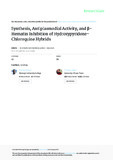| dc.contributor.author | Andayi, Andrew W | |
| dc.date.accessioned | 2017-02-23T13:59:07Z | |
| dc.date.available | 2017-02-23T13:59:07Z | |
| dc.date.issued | 2013 | |
| dc.identifier.other | dx.doi.org/10.1021/ml4001084 | ACS Med. Chem. Lett. 2013, 4, 642−646 | |
| dc.identifier.uri | http://hdl.handle.net/123456789/169 | |
| dc.identifier.uri | http://pubs.acs.org/doi/abs/10.1021/ml4001084 | |
| dc.description.abstract | A series of noncytotoxic 4-aminoquinoline-3-hydroxypyridin-
4-one hybrids were synthesized on the basis of a synergistic in vitro
combination of a precursor N-alkyl-3-hydroxypyridin-4-one with chloroquine
(CQ) and tested in vitro against CQ resistant (K1 and W2) and
sensitive (3D7) strains of Plasmodium falciparum. In vitro antiplasmodial
activity of the precursors was negated by blocking the chelator moiety via
complexation with gallium(III) or benzyl protection. None of the
precursors inhibited β-hematin formation. Most hybrids were more potent
inhibitors of β-hematin formation than CQ, and a correlation between
antiplasmodial activity and inhibition of β-hematin formation was
observed. Potent hybrids against K1, 3D7, and W2, respectively, were 8c (0.13, 0.004, and 0.1 μM); 8d (0.08, 0.01, and 0.02
μM); and 7g (0.07, 0.03, and 0.08 μM). | en_US |
| dc.language.iso | en | en_US |
| dc.publisher | American Chemical Society | en_US |
| dc.subject | antiplasmodial | en_US |
| dc.title | Synthesis, Antiplasmodial Activity, and β‑Hematin Inhibition of Hydroxypyridone−Chloroquine Hybrids | en_US |
| dc.type | Article | en_US |

